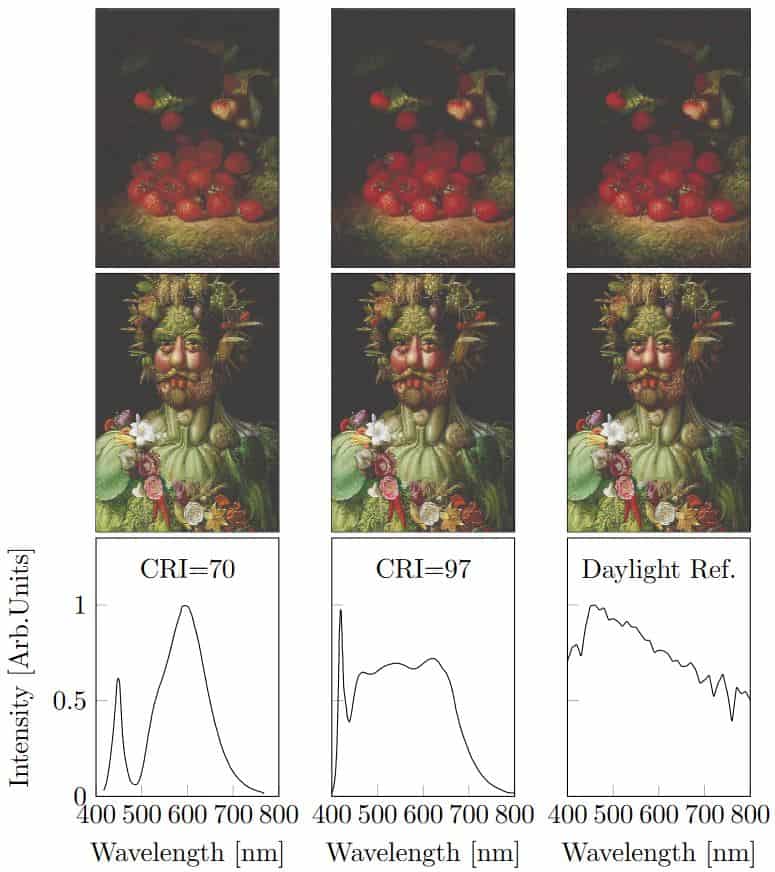Have you ever left the house feeling ok about your appearance, only to look in the bathroom mirror when you get to work and realize you look awful?
Your skin tone looks uneven, wrinkles look exaggerated, and the bags under your eyes appear darker than ever?
Unfortunately, we’ve all been the victim of unflattering lighting.
But this thinking exercise highlights an important point…
The color rendering index (CRI) of a light source can have a crucial and polarising effect on your home or workspace. CRI refers to how accurately a light displays color. At one end of the spectrum, high CRI bulbs will be extremely flattering and make colors’ pop’, but low CRI bulbs will deliver dull, washed-out colors.
As well as color temperature and lumen output, it’s vital to take note of the CRI of a bulb before you commit to purchasing.
Read on for a simple guide on what CRI is, why it is essential, and which type of lights have the best CRI.
What Is Color Rendering Index (CRI)?
CRI, color rendering index, was first established by the International Commission on Illumination to evaluate how effectively light sources display color.
Measured on a scale of 1 to 100, it is the only universally recognized color rendering metric. However, it’s vital to distinguish CRI from color temperature, which refers to how warm or cold a white light source is.
According to Rensselaer Polytechnic Institute, CRI is tested using 8 standard color swatches.
The swatches are illuminated by a test light source and compared to a reference illuminant of the same correlated color temperature. CRI is calculated from the difference in chromaticities between the test light and the reference light.
The smaller the average difference in chromaticities, the higher the CRI. So a CRI of 100 means that the test light performed exactly the same as the reference illuminant.
Just to give you an example, take a look at the image below. This is probably how you will see colors with low CRI compared to daylight.
Look a bit dull, doesn’t it?
So you’re probably unsurprised to hear that exact CRI cannot accurately be assessed by visual inspection. Instead, it requires a tricky calculation that is beyond the competency of everyday people like you and me.
The predefined color samples used to calculate CRI are often called ‘Ra,’ which stands for ‘rendering average.’ The scale actually contains 15 colors, but only indices R1 to R8 are used in the formula.
You’ll notice that the first 8 samples are unsaturated, pastel colors. For this reason, the CRI Ra is widely criticized, since it is not representative of a wide spectrum of colors. As such, there has been a shift towards using the extended ‘Re’ scale, which calculates CRI using all 15 color samples.
Why Is CRI Important When Selecting LED Lighting?

A survey conducted by the National Lighting Product Information Program found that people generally regard CRI as the most important consideration when choosing a light.
CRI received an average usefulness score of 3.5, compared to 3.2 for CCT, 3.1 for lamp type, and 1.9 for the brand name.
It is probably favored because of the stark difference between high CRI and low CRI lights.
LEDs with high CRI ratings will render colors accurately, which helps textures, fine details, and colors to stand out. This has a flattering effect on people, making their hair lustrous and skin look rich and healthy.
High CRI LEDs are valuable in both the home and workplace. In grocery stores, for example, fruit and vegetables will look juicier and more appetizing when displayed under high CRI lights.
In hospitals, whereas accurate color rendering is critical, and allows doctors to do their jobs safely.
Conversely, LEDs with low CRI ratings will make things appear drab and dull. Colors will not be portrayed accurately, which causes people to look unappealing and their skin to look lifeless.
It’s fair to assume that most people don’t want to look unpleasant, so high CRI LEDs are typically preferred over low CRI LEDs.
What Is The Good Number of CRI?
As a general rule of thumb, you should aim for a minimum CRI of 80. Though the closer to 100, the better. CRI is measured on a numeric scale of 1 to 100, so a score of 100 indicates that light is displaying colors exactly how they would appear in natural daylight.
CRI scores in the 90s are exceptional. They show colors almost as accurately as daylight, and any slight discrepancies will not be noticeable to the human eye. A CRI of 90 or higher is recommended for hospitals, museums, print studios, and retail shops.
Scores of 80 are also acceptable and may be useful in places that require softer or more ambient lighting. As CRI drops below 70, color inaccuracies will become more evident to the human eye.
Low CRI bulbs aren’t entirely invaluable, however. They may be beneficial when a gloomy effect is desirable, such as on movie sets or at horror attractions.
In some situations, minimum CRIs are mandated by law.
In California, for instance, Title 24 states that LED lights in residential buildings must have a minimum CRI of 90, and in particular, a minimum R9 value of 50.
Incandescent vs LED vs Fluorescent: Which Has Better CRI?
You and I both know that light bulbs are not always created equally. So what does this mean when it comes to CRI?
In the past, CRI was seen as relatively unimportant when choosing a light source. This is because traditional incandescent bulbs were popular.
Incandescent bulbs are essentially black body radiators, which means they have a perfect CRI score of 100.
However, incandescent bulbs have gradually been phased out in most countries due to their poor energy efficiency. As this happened, the importance of CRI became more apparent.
Fluorescent bulbs may seem like an attractive alternative to incandescent, due to the lack of heat they give off. But the CRI of a fluorescent varies from bulb to bulb and can be anywhere from 50 to 85.
The same is true of LEDs. In the past, LEDs were typically known to have poor CRIs. But as technology has evolved, LEDs have become better at color rendering than ever. Nowadays, most LEDs have an average CRI of 90.
Despite this, it’s worth noting that most LEDs have trouble at the infrared R9 end of the spectrum. An LED with an overall CRI of 95 could have an R9 value of 30.
But since CRI is calculated based on the average of all color samples, this is hidden. This is another common criticism of the CRI formula.
| Type of Bulb | Average CRI |
|---|---|
| Incandescent | 100 |
| Fluorescent | 50 to 80 |
| LED | 90 |
Related: Should I Switch From CFL To LED?
Final Words
So the next time you’re struggling to tell the difference between the black and brown shoes in your closet, blame the color rendering of your lighting!
Color rendering is an essential consideration when lighting your home or property, and the CRI calculation is used universally by the lighting industry. But it isn’t without limitations.
Back in 2015, the Illumination Engineering Society produced a replacement for the CRI that uses 99 color samples. So is color rendering about to get even more complex? I guess you’ll have to wait and see.
What CRI do you typically go for, are there any low CRI bulbs in your home? Share your thoughts below, it would be great to hear from you!
Looking for an LED bulb but not sure what type you need?
Check out my free bulb picker and select the right bulb within few clicks.


